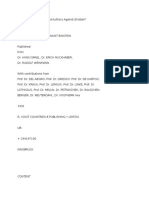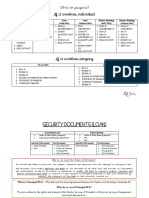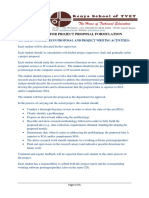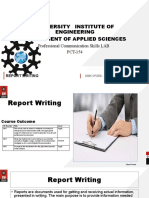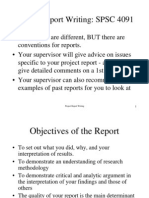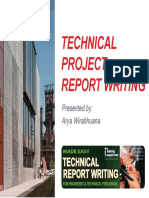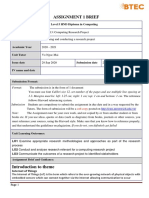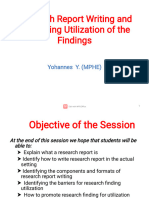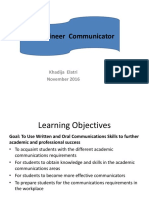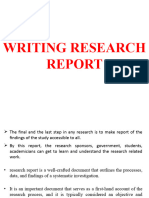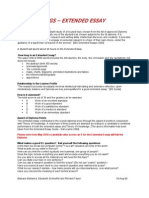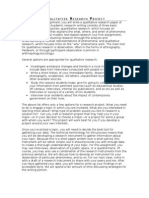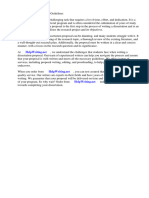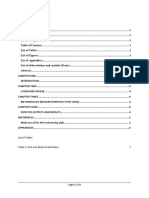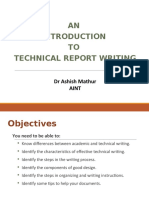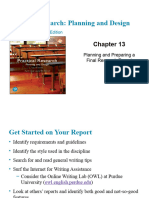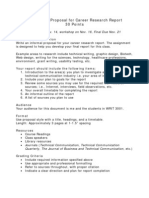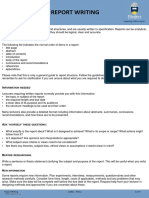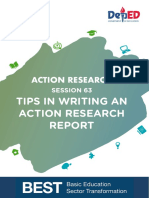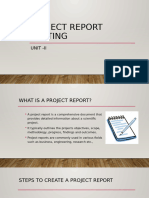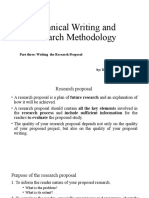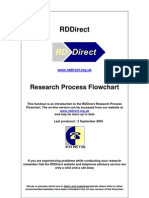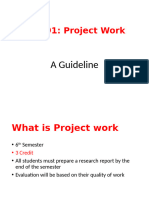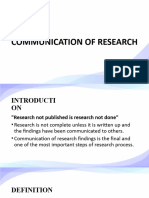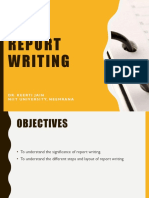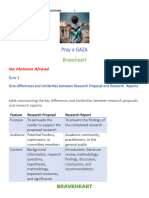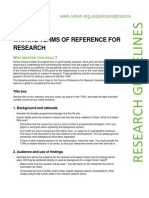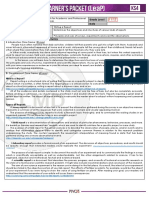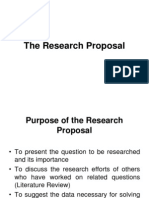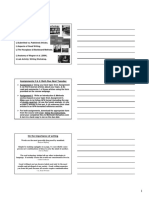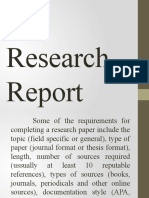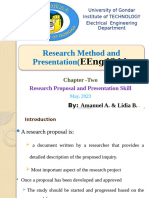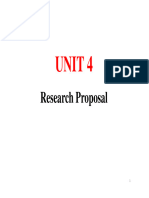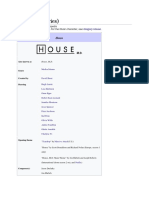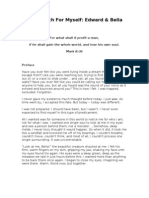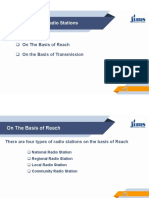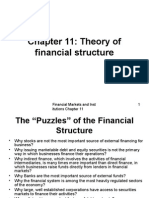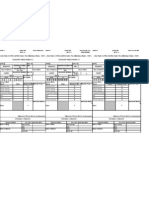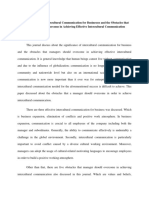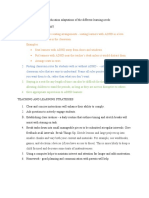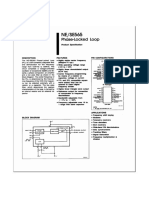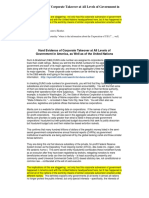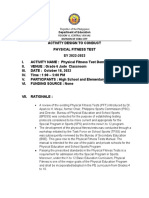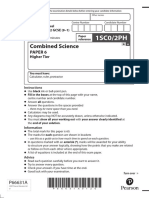0%(1)0% found this document useful (1 vote)
319 viewsRecommendation Report
Recommendation Report
Uploaded by
bayusenja89This document provides guidance on writing a recommendation report. It discusses including an introduction with background information and objectives. Data collection methods like reading, note-taking and research are also covered. The discussion section should present findings based on primary and secondary data and methodology. References should be included in APA style. The conclusion summarizes the report and implications. Overall, the document offers a framework for writing a recommendation report with key sections and content to include.
Copyright:
© All Rights Reserved
Available Formats
Download as PPTX, PDF, TXT or read online from Scribd
Recommendation Report
Recommendation Report
Uploaded by
bayusenja890%(1)0% found this document useful (1 vote)
319 views27 pagesThis document provides guidance on writing a recommendation report. It discusses including an introduction with background information and objectives. Data collection methods like reading, note-taking and research are also covered. The discussion section should present findings based on primary and secondary data and methodology. References should be included in APA style. The conclusion summarizes the report and implications. Overall, the document offers a framework for writing a recommendation report with key sections and content to include.
Original Description:
about recommendation report
Original Title
recommendation report
Copyright
© © All Rights Reserved
Available Formats
PPTX, PDF, TXT or read online from Scribd
Share this document
Did you find this document useful?
Is this content inappropriate?
This document provides guidance on writing a recommendation report. It discusses including an introduction with background information and objectives. Data collection methods like reading, note-taking and research are also covered. The discussion section should present findings based on primary and secondary data and methodology. References should be included in APA style. The conclusion summarizes the report and implications. Overall, the document offers a framework for writing a recommendation report with key sections and content to include.
Copyright:
© All Rights Reserved
Available Formats
Download as PPTX, PDF, TXT or read online from Scribd
Download as pptx, pdf, or txt
0%(1)0% found this document useful (1 vote)
319 views27 pagesRecommendation Report
Recommendation Report
Uploaded by
bayusenja89This document provides guidance on writing a recommendation report. It discusses including an introduction with background information and objectives. Data collection methods like reading, note-taking and research are also covered. The discussion section should present findings based on primary and secondary data and methodology. References should be included in APA style. The conclusion summarizes the report and implications. Overall, the document offers a framework for writing a recommendation report with key sections and content to include.
Copyright:
© All Rights Reserved
Available Formats
Download as PPTX, PDF, TXT or read online from Scribd
Download as pptx, pdf, or txt
You are on page 1of 27
BLHW 3403 ~ ENGLISH FOR PROFESSIONAL COMMUNICATION
English for Professional Communication
(BLHW3403)
2
RECOMMENDATION REPORT
A recommendation report compares two or more options (products,
properties, plans, process, etc), draws conclusions and makes a
recommendation.
Whenever an organization has to make an important decision, it may
seek carefully studied recommendations, e.g. office equipment:
computers, printers, copiers, FAX machines, and so on.
A recommendation report almost always has readers who have
different aspects of knowledge, which means its members know a lot
about one aspect of the topic.
Therefore a recommendation report writer must write reports that
allow readers to find what they need.
English for Professional Communication
(BLHW3403)
3
DATA COLLECTION
Before you start with your research, there are a few things that you
need to do to ensure that you will produce a good report.
Efficient reading allocate sufficient information to the research
Effective note taking avoid plagiarism, paraphrase instead
Efficient research
English for Professional Communication
(BLHW3403)
4
PRIMARY VS SECONDARY DATA
Data is one of the most important and vital aspects of any
research studies.
Data sources are broadly classified into primary and secondary
data.
1. Primary data = first-hand-experience, has not been published
yet e.g. interviews, surveys, lab work, etc.
2. Secondary data = has already been published, readily available
such as from books, journals, periodicals and internet.
SOURCES OF DATA
Experiment
e.g. Laboratory experiments
Questionnaires
e.g. Responses from a specific
audience
Interviews
e.g. Recordings of structured or
open-ended discussions on
certain predetermined topics
Field observations
e.g. Observation based on
people/activities in their
natural environments using
simple equipments
Archival collections
e.g. Public and/or private archival
and online data bases
English for Professional Communication
(BLHW3403)
5
English for Professional Communication
(BLHW3403)
6
TYPES OF RESOURCES
While writing a report, students need to consult several types of
resources to gather all the necessary data but credit should be
given for all the materials used from these sources.
Using information from a secondary source without citing the
source and giving credit to the author is an act of plagiarism.
It leads the reader to believe that the words are your own, so it
is unprofessional and unethical.
To avoid plagiarism is to provide proper documentation.
English for Professional Communication
(BLHW3403)
7
WRITING AN APA REFERENCE LIST
Books
Beer, D., & McMurray, D. (2005). A guide to writing as an engineer. USA:
John Wiley & Sons.
Article in a Newspaper
Hendry, W. A. (1990, April 9). Making the grade in todays schools. The
Country Today, pp. 135, 28-31.
An entry in an encyclopedia
Bergmann, P. G. (1993). Relativity. In The New Encyclopedia
Britannica (Vol. 26, pp. 501-508). Chicago: Encyclopedia
Britannica.
Article online
Bernstein, M. (2002). 10 tips on writing the living Web. A List Apart.
Retrieved May 2, 2006 from
http://www.cac.psu.edu/jbe/twocont.html
English for Professional Communication
(BLHW3403)
8
THE PROCESS OF WRITING A
RECOMMENDATION REPORT
This is the list of typical phases of writing a report.
1. Build a team
2. Find a topic related to your field or UTeM e.g. A Recommendation
Report on the Purchase of the Safest Sport Utility Vehicle (SUV) for
UTeM Development Office
3. Define an audience and purpose
4. Describe the objectives
5. Describe the problem and the background
6. Plan the review of literature
7. Describe the method/s - materials, equipment, facilities and procedures
8. Determine the criteria of comparison for both options e.g. safety,
driving experience, price, etc.
9. Present the results, findings, and data
10. Write the discussion, conclusions and recommendation
11. Format the list of information sources reference list
12. Plan the appendixes
13. Plan the format
15. Review and revise your rough draft
English for Professional Communication
(BLHW3403)
9
CHOOSING THE BEST TITLE
An effective title is informative but should be reasonably
short.
Ornamental or misleading titles may annoy readers.
Study Use Hardcopy Or Soft Copy
Comparison Between 2 Type Of Mp3 Player
Comparison Type Of Streamyx Package, Comparison Celcom
Broadband Package
Affordable Car For Student
The Differences Between External Hard Disk - Samsung
(500gb) Vs Buffalo ( 500gb)
English for Professional Communication
(BLHW3403)
10
FORMAT OF A RECOMMENDATION REPORT
1) Cover Page
Name of the University
Title of the report
Students names, metric number
Course code, semester
Name of the lecturer and
Date of submission
3) Body
Introduction
Background (cite from at least 2 sources)
Objectives
English for Professional Communication
(BLHW3403)
11
contd
Discussion
Method of research (qualitative / quantitative)
Recommendations (based on at least 3 criteria; explanation,
figures or tables)
Conclusion
Summary of the report / implication
4) End Matter
References (at least 2 references)
Appendixes (articles, pictures, etc.)
INTRODUCTION SECTION
An introduction is the most important element in a project report
as it helps to mentally prepare the readers to read the later part of the
report.
A good introduction should have sufficient amount of details to
direct readers quickly into the major text of the report.
The length of your introduction depends on how much they know
about the subject - if your audience is not very well versed on the
topic, then you need to cater to their needs by writing the introduction
in a semi-technical language.
The introduction section explains two aspects:
background of problem - (what is the research all about?)
objectives - (what is the aim of your research?)
English for Professional Communication
(BLHW3403)
12
Contd - background
Here are some ideas on information which could be used in presenting
the background section:
Provide a definition - The definition of electronic book (e-book)
Name the causes and effects - The effects of playing too much
online games among students
List the methods - Various ways of studying for final examination
Provide a historical background - The development of Twitter
Describe the problem The problems of designs Honda Accord
Compare ideas or methods - The different methods of assessing
the effectiveness of online classes
State advantages / disadvantages - The outstanding skills of
Christiano Ronaldo as a footballer
English for Professional Communication
(BLHW3403)
13
Contd - objectives
The objective informs the reader the purpose of the research and why
the report is written.
Explain why you are writing
What do you want to find out?
What is the goal of your research?
Is your objective clear, concise and straight to the point?
The objectives of this study are/were to;
i. compare differences between the roles, opportunities and
achievements of women; then and now
ii. suggest the better life led by women; then or now?
English for Professional Communication
(BLHW3403)
14
DISCUSSION SECTION
This section presents, discusses, explains, analyses, compares,
evaluates, interprets and infers the recommendations for the topic
based on the research objectives raised at the beginning of the
study.
The is presented in the forms of figures and written text.
Graphical illustrations, tables and diagrams present the complete
findings in numerical terms.
The accompanying text helps the reader to focus on the most
important aspects of the recommendation and to interpret them.
English for Professional Communication
(BLHW3403)
15
Contd - methodology
It starts with a brief discussion on the methodology used in the
research;
method/s qualitative or quantitative
materials/equipment/facilities
procedures
Method used could come from either surveys, questionnaires,
tests, experiments (primary data)
It could also rely on printed materials such as books, journals,
newspapers, magazines, or even internet (secondary data)
English for Professional Communication
(BLHW3403)
16
Contd - discussion
This section is specially to discuss your recommendations and
suggested solution/winner
This is where you interpret, explain, and support every
recommendation
It starts with a paragraph of introduction to the section,
followed by the discussion on the recommendations and finally
the chosen solution.
Your discussion should move from general to specific.
English for Professional Communication
(BLHW3403)
17
Contd - Organising the
Discussion Section
English for Professional Communication
(BLHW3403)
18
Type A Type B
Recommendations
Criterion 1
(option A and B )
Criterion2
(option A and B )
Criterion3
(option A and B )
Recommendations for Option A
Criterion 1
Criterion 2
Criterion3
Recommendations for Option B
Criterion1
Criterion 2
Criterion 3
Contd - Reporting the Recommendation
Section
Element 1: Introducing the Recommendation Section
Element 2: Presenting the Criteria
Element 3: Commenting on the Criteria
Element 4: Concluding the Recommendation
English for Professional Communication
(BLHW3403)
19
Contd -Element 1: Introducing the
Recommendation Section
Use a simple explanation to introduce the recommendation
section of the report by writing a topic sentence that states
the main idea of the section.
Example:
inform the reader the overall content of the section
highlight graphical illustrations used in presenting the results
explain the procedure or method of the experiment/
investigation. Examples:
A survey was conducted among 20 future engineers
This part will present
The aim of this experiment is
This recommendation section will present the criteria chosen and
results obtained based on a survey to find out which communication
method is most preferable by people nowadays; calling or texting, thus
three criteria will be discussed at length; process, delivery and cost.
English for Professional Communication
(BLHW3403)
20
Contd - Element 2: Presenting the Criteria
The most common way of presenting the result of each
criterion of a study is through tables, graphs, charts, diagrams,
photographs, etc.
However, the illustrations are not able to provide explanations
so the writer needs to integrate the illustrations with the written
discussion of the results.
Initially, the finding of each criterion of the study followed by
interpretation or comment.
Starts with the LEAST important results.
English for Professional Communication
(BLHW3403)
21
Contd
Examples:
According to the statistics, the popularity of Internet Explorer
had an 20% increase as compared to Mozilla Firefox from
2005 2010.
Figure 2 shows the percentage of
The pie chart reveals that .
The results from the analysis are presented in Table 2.
The graph in Figure 5 shows that
Table 1 above describes the .
English for Professional Communication
(BLHW3403)
22
contd - element 3: Commenting on the results
for each criterion
The comments on results and discussion section may serve a
variety of functions:
to explain possible reasons for the results
to compare the results of the research with the results from other
studies within the same field
to evaluate the results by providing an assessment of the results
(whether the results obtained are expected or unsatisfactory)
Examples:
A possible explanation for this might be that Toyota Camrys beefy,
aggressive, street demon look seems cannot be detected in Honda
Accord.
It seems possible that these results are due to
This result may be explained by the fact that
These variations can be explained in part by
English for Professional Communication
(BLHW3403)
23
contd - element 4: Concluding the Results
This element states the implications of the work which may
include either positive or negative findings.
relate your findings to the original objective; interpret and
compare; point out special features of your work; discuss
limitations and discrepancies; demonstrate whether you have
solved the problem.
Examples:
In general, it seems that Hyundai Motor Company has beaten out
Kia in several criteria discussed.
One weakness while conducting this research is
Overall, the results of the study suggest that
The results of the study indicate that
English for Professional Communication
(BLHW3403)
24
Conclusion/Recommendation
The conclusion section contains the summary of the whole report
what knowledge comes out of the report?
As you draw a conclusion, you need to explain it in terms of the
preceding discussion
Some repetition of the most important ideas you presented there is
expected, but you should avoid copying
What actions does the report call for?
The final recommended choice should be clearly connected to the
results of each criterion in the report.
This section may also include plans for how further research should
proceed.
English for Professional Communication
(BLHW3403)
25
Reference List & Appendixes
These will include references and may include appendices
Any research that you refer to in the report must also appear in a
list of references at the end of the work so that an interested reader
can follow up your work
Since the format for references varies across engineering, consult
your instructor, or check a style manual for the field
Appendices may include raw data, calculations, graphs, and other
quantitative materials that were part of the research, but would be
distracting to the report itself
Refer to each appendix at the appropriate point (or points) in your
report
English for Professional Communication
(BLHW3403)
26
You might also like
- 100 Authors Against Einstein English TranslationDocument316 pages100 Authors Against Einstein English TranslationAnon ymouse75% (4)
- SITXFSA005 Slideshow.v1.0Document47 pagesSITXFSA005 Slideshow.v1.0Aaryann JyswalNo ratings yet
- Melanoma 2016Document413 pagesMelanoma 2016Anca-Raluca Pascu100% (2)
- Conveyancing Notes 1Document8 pagesConveyancing Notes 1Syarah Syazwan Satury67% (6)
- Proposal Guideliness 2023Document5 pagesProposal Guideliness 2023christine nasikeNo ratings yet
- University Institute of Engineering Department of Applied SciencesDocument24 pagesUniversity Institute of Engineering Department of Applied SciencesAnil PradhanNo ratings yet
- HUM102 Assignment 3-Project PDFDocument7 pagesHUM102 Assignment 3-Project PDFHamza RaufNo ratings yet
- BMAN71751 2023-24 - Assessment BriefDocument7 pagesBMAN71751 2023-24 - Assessment Briefwfxd8dynb6No ratings yet
- Assignment 4 - Research ProposalDocument4 pagesAssignment 4 - Research ProposalSyed Kaleem GilaniNo ratings yet
- Adama Science and Technology University School of Civil Engineering and ArchitectureDocument26 pagesAdama Science and Technology University School of Civil Engineering and ArchitectureAhmed MohmmedNo ratings yet
- Report Writing: Dr. M. Vijay Kumar SharmaDocument27 pagesReport Writing: Dr. M. Vijay Kumar SharmaBaba KelaNo ratings yet
- Project Guidelines Sep0623Document7 pagesProject Guidelines Sep0623Mina RezaeiNo ratings yet
- Proj ReportDocument31 pagesProj ReportK Sudarshana ReddyNo ratings yet
- Project ReportingDocument127 pagesProject Reportingmuhammad zulfikarNo ratings yet
- 1639 GCS200104 NguyenHoangPhuong Assignment1 2Document38 pages1639 GCS200104 NguyenHoangPhuong Assignment1 2Pham Cong Minh (FGW HCM)No ratings yet
- 1-Technical Report Writing PDFDocument26 pages1-Technical Report Writing PDFLan PhanNo ratings yet
- 05.report (1)Document65 pages05.report (1)barajaalalaa133No ratings yet
- Engineering CommunicatorDocument32 pagesEngineering CommunicatorMohammed MamdouhNo ratings yet
- Bch413 Ln3 Report Writting CurrDocument36 pagesBch413 Ln3 Report Writting CurridriscognitoleadsNo ratings yet
- Itgs - Extended EssayDocument6 pagesItgs - Extended EssayBarbara MarbanNo ratings yet
- Writing and Communicating The ReportDocument26 pagesWriting and Communicating The ReportMd. Younus MiahNo ratings yet
- CHAPTER 7 Writing A Research ReportDocument9 pagesCHAPTER 7 Writing A Research ReportNeil Henessy Casuncad CuareNo ratings yet
- Research, Which Focuses More On The "Why" Phenomena Work. The Main ToolDocument4 pagesResearch, Which Focuses More On The "Why" Phenomena Work. The Main ToolkinoglazNo ratings yet
- PHD Dissertation Proposal GuidelinesDocument6 pagesPHD Dissertation Proposal GuidelinesBuyCustomPapersUK100% (1)
- Guidelines Data Science Project PX55PA PBDocument4 pagesGuidelines Data Science Project PX55PA PBvrajesh pandhiNo ratings yet
- Proposal Guideliness 2024Document6 pagesProposal Guideliness 2024ndirajeffaNo ratings yet
- An Introduction To Technical Report Writing - AMDocument30 pagesAn Introduction To Technical Report Writing - AMSmyle KatariaNo ratings yet
- Easp ReportDocument24 pagesEasp ReportRence Ian OraaNo ratings yet
- CH13 PPTDocument21 pagesCH13 PPTAliaa HabibNo ratings yet
- WRIT 3001 Proposal For Career Research ReportDocument1 pageWRIT 3001 Proposal For Career Research ReportjpbartolottaNo ratings yet
- How To Write An Academic ReportDocument37 pagesHow To Write An Academic ReportYulyana AnjaniNo ratings yet
- Report+Writing +textDocument4 pagesReport+Writing +textjonaNo ratings yet
- 6.3 Tips in Writing Action ResearchDocument10 pages6.3 Tips in Writing Action ResearchArchessNo ratings yet
- RM MaterialDocument9 pagesRM Materialreeva046No ratings yet
- CH 1 Fundamental Principles of Technical WritingDocument48 pagesCH 1 Fundamental Principles of Technical WritingYohanis Agumase100% (1)
- Reports Lecture 3rd Year 1st TDocument8 pagesReports Lecture 3rd Year 1st Tayahayah798No ratings yet
- Unit 2-Report WritingDocument13 pagesUnit 2-Report Writinghariharanarthi15No ratings yet
- Technical Writing and Research MethodologyDocument30 pagesTechnical Writing and Research MethodologykuleniNo ratings yet
- Research FlowchartDocument22 pagesResearch FlowchartMuhammad ZafranNo ratings yet
- BBA Project Work Guidelines PptDocument32 pagesBBA Project Work Guidelines PptAshmina ShahiNo ratings yet
- Communication of ResearchDocument37 pagesCommunication of Researchlohithranjan6No ratings yet
- UT Dallas Syllabus For Pa6326.501.09f Taught by (jlh085000)Document13 pagesUT Dallas Syllabus For Pa6326.501.09f Taught by (jlh085000)UT Dallas Provost's Technology GroupNo ratings yet
- RM Merged2 PDFDocument127 pagesRM Merged2 PDFTushar GoelNo ratings yet
- 6465 B.ed Guess Paper SolvedDocument39 pages6465 B.ed Guess Paper SolvedSaqib TipoNo ratings yet
- Amity Global Business School: by Srikanth VenkataswamyDocument22 pagesAmity Global Business School: by Srikanth VenkataswamyArchana MenonNo ratings yet
- Total Marks: 200, Total Credit Points: 6 Motto of The Program: To Make Sure Quality EducationDocument4 pagesTotal Marks: 200, Total Credit Points: 6 Motto of The Program: To Make Sure Quality EducationSanjida Islam MimNo ratings yet
- Writing Terms of Reference For ResearchDocument6 pagesWriting Terms of Reference For ResearchOxfamNo ratings yet
- ICT615 Assignment 1Document4 pagesICT615 Assignment 1Ammad Hussain khichiNo ratings yet
- GuidelinesDocument23 pagesGuidelinessumanNo ratings yet
- LAS English in Academic Purpose Quarter Module 3Document4 pagesLAS English in Academic Purpose Quarter Module 3Abigail MasotisNo ratings yet
- Lesson Three - 22 FebDocument38 pagesLesson Three - 22 FebJunejo MichaelNo ratings yet
- How To Write An Academic ReportDocument37 pagesHow To Write An Academic ReportbrendaNo ratings yet
- Unit - 34 - Research - Project - Assignment Brief - 17EDDocument7 pagesUnit - 34 - Research - Project - Assignment Brief - 17EDTân Nguyễn50% (2)
- BCH413 LN3 Report Writting CurrDocument34 pagesBCH413 LN3 Report Writting CurrHaroon rahamatNo ratings yet
- How To Write An Academic ReportDocument37 pagesHow To Write An Academic Reportmukiibirhines2001100% (1)
- Modified Aibs Dissertation Guidelines 1Document12 pagesModified Aibs Dissertation Guidelines 1Aabhash KiranNo ratings yet
- Writing Research Reports in Psychology: Rudyard KiplingDocument7 pagesWriting Research Reports in Psychology: Rudyard KiplingRenee JonesNo ratings yet
- Research ReportDocument17 pagesResearch ReportRaymond Jay TambongNo ratings yet
- Research Method and Presentation Chapter 2-1Document61 pagesResearch Method and Presentation Chapter 2-1asrattsegaye224No ratings yet
- 6 Research Design & MethodsDocument62 pages6 Research Design & MethodsMulugeta BezaNo ratings yet
- Technical Report Writing for Engineers Sheet I-1Document27 pagesTechnical Report Writing for Engineers Sheet I-1abdo094459034hih0No ratings yet
- Unit V (MBA 206)Document45 pagesUnit V (MBA 206)Gunjan AwalNo ratings yet
- Chapter 4 R (2017)Document50 pagesChapter 4 R (2017)samioro746No ratings yet
- ChatGPT Guide to Scientific Thesis Writing: AI Research writing assistance for UG, PG, & Ph.d programsFrom EverandChatGPT Guide to Scientific Thesis Writing: AI Research writing assistance for UG, PG, & Ph.d programsRating: 4 out of 5 stars4/5 (1)
- House (TV Series)Document3 pagesHouse (TV Series)Carlos PegueroNo ratings yet
- Fan Fiction - The Search For MyselfDocument408 pagesFan Fiction - The Search For MyselfBlueFallenAngel89% (9)
- Types of Radio StationsDocument13 pagesTypes of Radio Stationsdepak_deepNo ratings yet
- Reliance Industries AGM: Here Are Key Takeaways From Mukesh Ambani's SpeechDocument4 pagesReliance Industries AGM: Here Are Key Takeaways From Mukesh Ambani's SpeechSamil MusthafaNo ratings yet
- Cell File Srs FinalDocument105 pagesCell File Srs FinalfraitelNo ratings yet
- Bridge Over Troubled Water" Experiences of Retiring Teachers Shifting To A Pedagogical MilieuDocument13 pagesBridge Over Troubled Water" Experiences of Retiring Teachers Shifting To A Pedagogical MilieuAPJAET JournalNo ratings yet
- Aws Infrastructure Event ReadinessDocument41 pagesAws Infrastructure Event ReadinessInter 4DMNo ratings yet
- Chapter 15Document11 pagesChapter 15Aylan765No ratings yet
- MTR 6Document1 pageMTR 6Nitin VishwakarmaNo ratings yet
- Garments & CleanareasDocument59 pagesGarments & Cleanareasvishalsharma100% (1)
- The Significance of Intercultural Communication For Businesses and The Obstacles That Managers Should Overcome in Achieving Effective Intercultural CommunicationDocument2 pagesThe Significance of Intercultural Communication For Businesses and The Obstacles That Managers Should Overcome in Achieving Effective Intercultural CommunicationAnonymous 3L7ZroJIzhNo ratings yet
- Day01 Business Intelligence - ItiDocument16 pagesDay01 Business Intelligence - ItikirolosmagdyNo ratings yet
- St06032fu1 PDFDocument11 pagesSt06032fu1 PDFJamyang Palmu KatukNo ratings yet
- WT MCQ For InsemDocument49 pagesWT MCQ For InsempoiNo ratings yet
- Troubleshooting Guide: Electropneumatic PositionersDocument73 pagesTroubleshooting Guide: Electropneumatic Positionersloli2323No ratings yet
- General Education Adaptations of The Different Learning NeedsDocument10 pagesGeneral Education Adaptations of The Different Learning NeedsMary Ann MendezNo ratings yet
- Technology Breadmaking: SpringerDocument11 pagesTechnology Breadmaking: Springerawaisqarni640No ratings yet
- Natural Muscovite Block Mica and Thins Based On Visual QualityDocument6 pagesNatural Muscovite Block Mica and Thins Based On Visual QualityMaxNo ratings yet
- NE565Document6 pagesNE565KoesNo ratings yet
- Sika Boom: Expanding Polyurethane FoamDocument3 pagesSika Boom: Expanding Polyurethane FoamBalasubramanian MahadevanNo ratings yet
- Summer Internship Project HRM Bba MbaDocument67 pagesSummer Internship Project HRM Bba Mbariyagupta221200No ratings yet
- 12892+NBHA+Farooq+2022 12 06Document14 pages12892+NBHA+Farooq+2022 12 06Aqsa khanNo ratings yet
- Hard Evidence of Corporate Takeover at All Levels of Government in AmericaDocument4 pagesHard Evidence of Corporate Takeover at All Levels of Government in AmericaMichaelMationschek100% (2)
- Battery Inverter: 5 KVA: Lot 1 Boq (Amran)Document2 pagesBattery Inverter: 5 KVA: Lot 1 Boq (Amran)MOHAMMED. HAKAMINo ratings yet
- Activity DesignDocument3 pagesActivity DesignJosiah Emmanuel CodoyNo ratings yet
- 1SC0 2PH Que 20211202Document20 pages1SC0 2PH Que 20211202yasNo ratings yet
